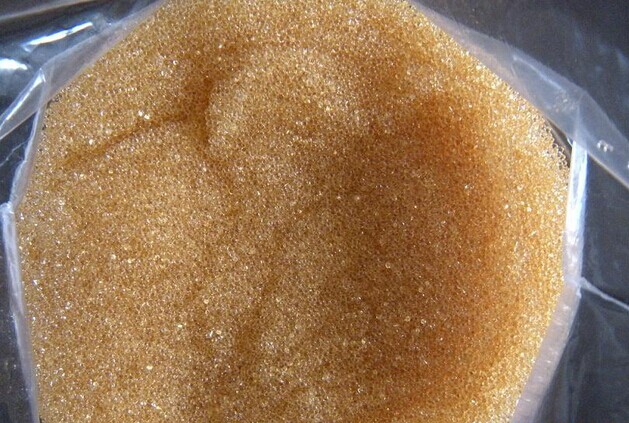成都森格尔环保科技有限公司
Chengdu senge environmental protection technology co.LTD
Consultation Hotline:02865357899
Production, Sales and Development of Ion Exchange Resin
成都森格尔环保科技有限公司
Chengdu senge environmental protection technology co.LTD
Consultation Hotline:02865357899
Production, Sales and Development of Ion Exchange Resin
Contact person: Manager Liu
Location: 028-65357899
Mobile phone: 15680686111
Mailbox: chengdu@sgrhb.com
Fax: 028-65357899
Email: chinaresin@sgrhb.com
Website: www.sgrhb.com
Website : en.sgrhb.com
Address: 79 Jiujin Street, Wuhou District, Chengdu City, Sichuan Province

Ion exchange resin. Ion exchange resin is composed of classification name, skeleton (or gene) name and basic name. The pore structure is divided into two types: gel type and large pore type. All macroporous resins with physical pore structure are added "big hole" before the full name. If the classification is acidic, the word "yang" should be added before the name, while the classification is alkaline, and the word "yin" should be added before the name. Such as: macroporous strong acidic styrene cation exchange resin. Preparation
There are two main raw materials for ion exchange resins: styrene and acrylic acid. They are copolymerized with divinylbenzene as crosslinking agent to form a polymer with long molecular backbone and cross-linked transverse chains. First use styrene resin, then acrylic resin.
and
Resins have good adsorption properties, but they have different properties. Acrylic resin can exchange and adsorb most of the ionic pigments. It has great decolorization ability and adsorbent is easy to be eluted and regenerated. It can be used as the main decolorizing resin in sugar mills. Styrene resin is good at adsorbing aromatic and polyphenolic substances (including negatively charged or non-charged substances) in sugar juice. However, it is difficult to be eluted during regeneration. Therefore, using acrylic resin to decolorize sugar solution roughly and then using styrene resin to refine decolorization can give full play to the advantages of both.
The crosslinking degree of ion exchange resin, i.e. the amount of divinylbenzene in resin matrix polymerization, has a great influence on the properties of resin. Ion exchange resin is composed of classification name, skeleton (or gene) name and basic name. The pore structure is divided into two types: gel type and large pore type. All macroporous resins with physical pore structure are added "big hole" before the full name. If the classification is acidic, the word "yang" should be added before the name, while the classification is alkaline, and the word "yin" should be added before the name. Such as: macroporous strong acidic styrene cation exchange resin. Ion exchange resins can be divided into styrene resin and acrylic resin according to their matrix types. The main properties and types of resins are determined by the types of chemical active groups in resins. Firstly, it can be divided into cationic resins and anionic resins, which can exchange ions with cations and anions in solution respectively. Cationic resins can be divided into strong acidity and weak acidity. Anionic resins can be divided into strong alkalinity and weak alkalinity. Usually, the resin with high crosslinking degree is more compact, fast, durable, dense, with small internal voids and strong selectivity to ions. However, the resin with low crosslinking degree has large porosity, strong decolorization ability and fast reaction speed, but it has high expansibility, low mechanical strength, brittleness and fragility. The crosslinking degree of industrial ionic resins is generally not less than 4%. The crosslinking degree of the resin used for decolorization is generally not more than 8%. The crosslinking degree of resin used for adsorbing inorganic ions is higher.
In addition to the above two series of styrene and acrylic acid, ion exchange resins can also be polymerized by other organic monomers. Such as phenols (FP), epoxy (EPA), vinylpyridine (VP), urea formaldehyde (UA), etc.
Ion exchange resin in refined sugar
The application of exchange resin in dissociation production can remove all kinds of impurities in sugar solution. Especially colored substances and ashes. Because of the high price of resin and the large investment between resin and equipment, it needs to be recycled regularly to keep the resin in good performance. If the processed material contains more impurities, the working cycle of the resin will be shortened and the cost of regeneration will be increased. Therefore, it is mainly used in refinery to produce refined sugar and high quality syrup. In order to prolong the working life and service life of the resin, reduce consumption and cost, the sugar solution must be properly pretreated before passing through the resin column to remove most of the non-sugar in the raw material. Especially, the resin has larger pollutants in refined sugar production.
ion exchange resin
Its main purpose is to remove pigments, so the resin has a high decolorization performance. According to the selection of suitable resin varieties and combinations, as well as various technical conditions, as a basis for design and production operation.
The raw sugar soluble syrup is treated with resin and the white sugar soluble syrup is treated with resin. The first grade resin is regenerated with NaOH solution, and the pH value is adjusted by acidification. The secondary resin was regenerated with alkaline brine.
Chengdu Senger Environmental Technology Co., Ltd.
Record No: 蜀ICP备19000327号
Powered by Xiangyun Platform
Contact person: Manager Liu
Location: 028-65357899
Mobile phone: 15680686111
Email: chinaresin@sgrhb.com

